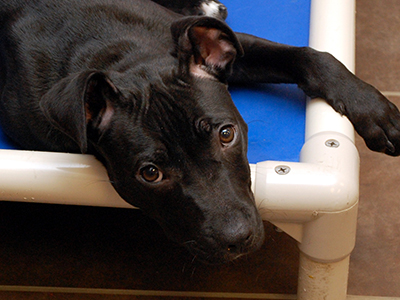 What is resource guarding?
What is resource guarding?
Resource guarding is a fairly common canine behavior issue, and can be among the most serious of behavior problems if it is not managed properly. In the wild, resources are scarce, and wild dogs learned to guard their food, shelter, and other resources from other animals in their environment. This predisposition to protecting valued objects has carried over into domestic dogs and translates as defensive aggression when a dog feels his possessions are in danger (and consequently, that his survival is being threatened).
What objects are resources?
A high-value resource is anything that your dog considers to be high value. Objects that are most likely to be guarded are food bowls, rawhides, bones, pig’s ears, and other edible, tasty objects. However, favorite sleeping spots, beds, furniture, toys, crates, garbage, other dogs, and even people are sometimes considered high-value resources!
What does resource guarding look like?
Avoidance, stiffening, hard eye contact, body blocking, growling, snarling and snapping are all warning signs that dogs give when they are uncomfortable. The vast majority of dogs will give multiple warnings signs before actually committing to a bite. Resource guarding does NOT make your dog a “bad dog”. Just a dog in need of some management.
Plan of action
As a responsible dog guardian, it is important to teach your dog to be comfortable with you around his food and objects.
- When the dog is eating throw high valued rewards into the food bowl, ensure that you are far enough away that the dog does not feel the need to challenge you.
- Hand feeding your new dog some of his meals may help you to establish yourself as the provider of the food (instead of the person who takes the food away!).
- Teaching your dog to trade his objects for treats can become a fun game for him, and can ensure that you are safely able to take objects away, if needed.
- Restricting high value chewies (like rawhides or bones) is a good idea, until your dog shows regular willingness to trade objects with you.
- Teaching your dog a “leave it” command and a “drop it” command will make it easier for you to safely take objects away from him.
- Making your dog earn every toy, treat, or snack with a sit or a down is a good way to show him acceptable ways of obtaining resources.
Confining your dog in situations where food can be taken and guarded from people (i.e., family dinners, children’s parties) will prevent him from getting himself into trouble if he ever feels the need to guard a resource.
What NOT to do
If you punish your dog for guarding his resources, he will likely view this as you fighting aggression with aggression, and become more defensive of his objects. If your dog shows any signs of possession, please do not try to take his object away from him. Instead, offer a trade or wait until he finishes with the object before removing it.



